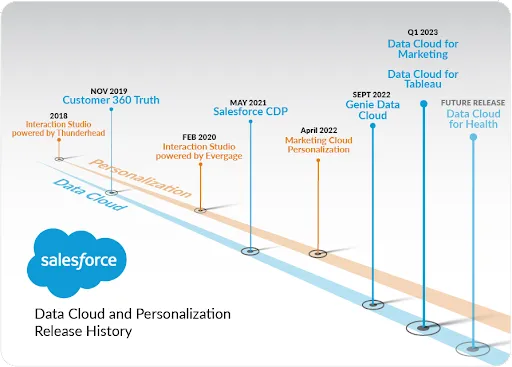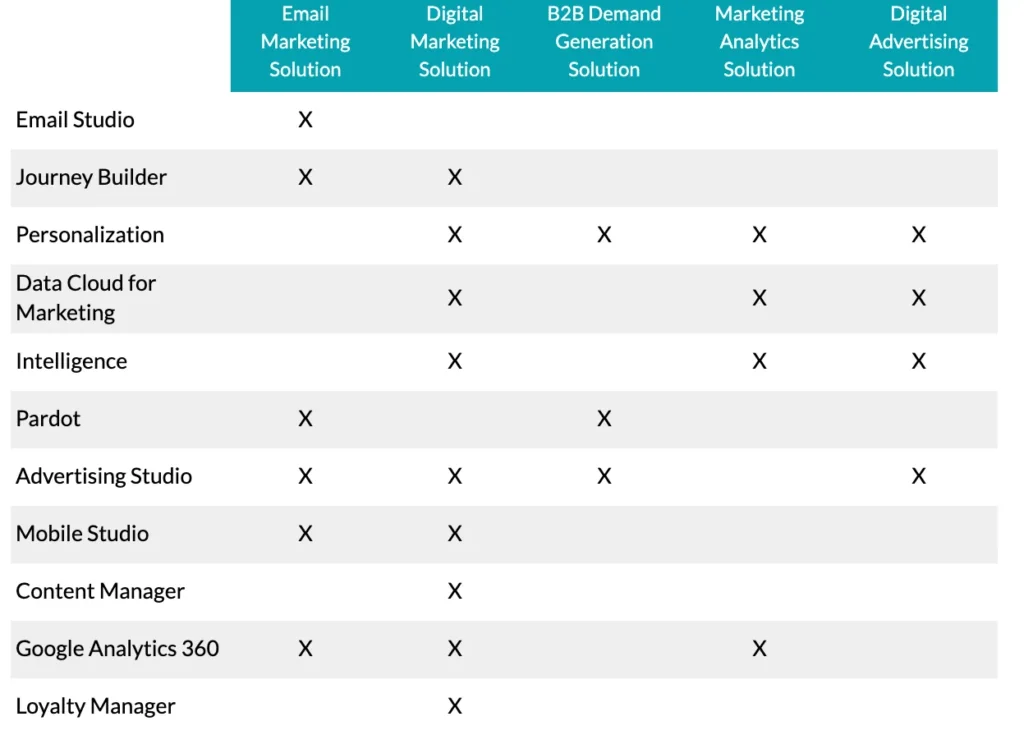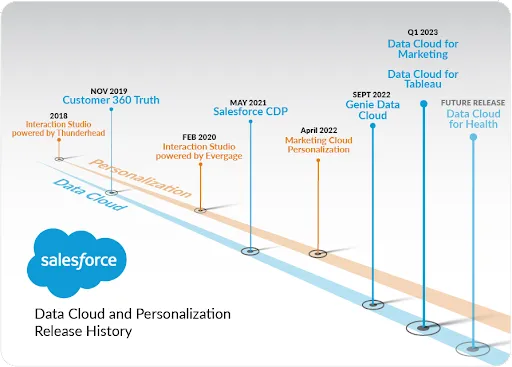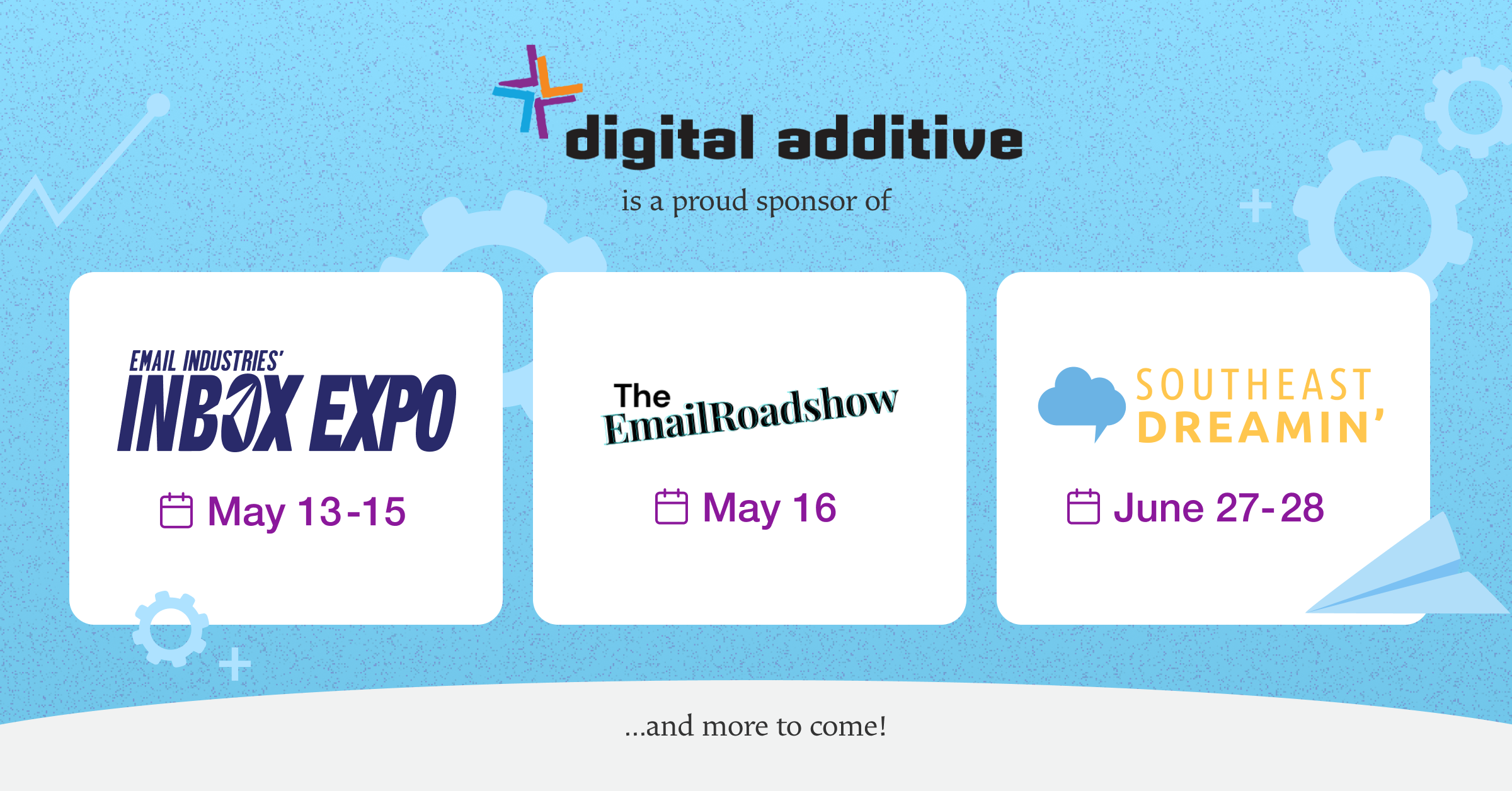This month, Digital Additive is focusing on Customer Data Platforms — what they are, why they’re important, and the ways that Salesforce leverages them through Data Cloud and Personalization.
We turned to our partners at Search Discovery for an in-depth exploration of the evolution of Salesforce CDP, Genie, Data Cloud, and Personalization to help clients sort through the facts and learn what the right fit is for their company.
The following is a repost from Search Discovery
This post distinguishes features, benefits, and use cases for the Salesforce Data Cloud for Marketing (Data Cloud), Data Cloud for Tableau (Data Cloud), and Marketing Cloud Personalization (Personalization).
Search Discovery helps clients select and implement the correct platform based on each client’s unique business requirements. Read more to see if either or both of these solutions might work for you.
Multichannel marketers and large-scale advertisers with integrated marketing goals are busy scouring the web (and answering marketing emails) to answer these questions: Do I need a CDP? and, Which is the best fit for our brand?
We help clients answer these questions through our partnerships with major CDP vendors, including Salesforce. We’ve also developed a CDP ROI tool to quantify the potential impact of deploying one of these tools. Using our tool-agnostic approach, we help clients find the best CDP for their business requirements in both B2B and B2C spaces.
Why do companies invest in Salesforce Data Cloud or Personalization?
In the latest Salesforce State of Marketing report, 78% of high performers used a CDP, vs. 58% of underperformers. CDPs are important right now because they help deliver excellent, personalized client experiences, address current challenges marketers face, and help marketers drive growth.
- Marketers must create targeted, personalized, actionable campaigns: CDPs manage ID resolution, customer profile building, real-time customer segmentation, and activation capabilities within user-friendly interfaces that don’t rely on IT resources.
- Marketers have siloed customer data: CDPs ingest, unify, and integrate customer data across channels, making that data accessible to other marketing and analytic tools.
- Marketers face growing data governance and privacy demands: CDPs respect consumer privacy and safely govern your data while complying with CCPA and GDPR regulations.
- Marketers face measurement problems with the disappearance of third-party cookies: CDPs create centralized, accurate campaign measurement with analytics and data science (machine learning, predictions, recommendations) and boost the value of your first-party data asset.
Untangling the history of Data Cloud and Personalization
Salesforce has two CDP products available, but these products have had several name changes! Hopefully, or graphic below, paired with a narrative history of the products, helps clear things up.

Personalization release history
Personalization was the first Salesforce CDP product to market. It was initially a white-labeled CDP platform out of the UK called ‘Thunderhead,’ launched in 2018. Salesforce replaced Thunderhead when they acquired the Evergage platform in February 2020 and rebranded the Evergage platform as ‘Interaction Studio’ (Thunderhead is now an independent customer journey orchestration tool that works with — but is not a part of — the Salesforce ecosystem). In April 2022, ‘Interaction Studio’ became ‘Marketing Cloud Personalization.’
Data Cloud release history
At the same time that those changes were in the works, Salesforce was investing in building its own CDP, which is different from (but connects with) Personalization. It was initially developed under ‘Customer 360 Truth,’ but was renamed ‘Salesforce Customer Data Platform’ with the Summer 2021 (May) release. When the real-time version was announced at Dreamforce 2022, it was known briefly as ‘Genie.’ The first release in 2023 incorporated data from the full Salesforce ecosystem (i.e., Customer 360), and the product was renamed ‘Data Cloud for Marketing.’
In a February 2023 partner briefing, Salesforce announced Data Cloud for Tableau and Data Cloud for Health. Data Cloud for Tableau was GA (general availability status) at that time, and Data Cloud for Health was expected to be GA in the next release. The product functionality is essentially the same at the time of the release. So, for the balance of this post, we’ll refer to them collectively as ‘Data Cloud.’
A note on licensing and positioning
In that same February partner briefing, Salesforce announced that they’re moving away from all-in license pricing to a usage-based model that, while complex, does a better job of allowing customers to match costs with benefits from the platform.
Data Cloud is currently positioned as the Salesforce “long-term CDP solution,” and when you buy it, Messaging and Journeys are included as a part of its unified marketing solution. You can license one or both of these products. Both tools have a great deal of potential for clients who are using other Salesforce Clouds.
Salesforce Marketing Cloud product orientation
Two of these products live within the Salesforce ecosystem under Salesforce Marketing Cloud. Salesforce categorizes the products under the five solution headings in the columns below. The table below compiles information from the Marketing Cloud website to map which products fit within each solution.

How are Data Cloud and Personalization differentiated?
Salesforce positions its products within two buckets that differentiate systemic functionality. These two buckets are:
- Insights — including data capture, data harmonization, data unification, and segmentation; and
- Engagement — digital experience personalization, dynamic optimization, messaging personalization — like email, SMS, or push, and “next best offer/action” — across endpoints like call center, POS, etc.
There are areas of functional overlap within these buckets and among the two options. However, this bucketing system puts Data Cloud into the insights bucket and Personalization in the engagement bucket.
At this stage, Data Cloud caters to brands looking to scale insights-driven capabilities and activation, whereas Personalization is most focused on real-time interaction management and personalization. However, the Salesforce roadmap seeks to combine the Data Cloud insights with Personalization’s engagement focus and to connect seamlessly with all the products within the Marketing Cloud for an integrated digital 360 customer data experience.
Since Data Cloud now has real-time or near real-time processing capabilities, the distinction between the two products has been somewhat blurred. Data Cloud doesn’t have the experience orchestration capabilities of Personalization; it can’t execute things like web personalization at the time of a visit or open-time email personalization. However, it now has the potential to deliver those engagement instructions for an audience to the martech stack, where it can be executed by other Salesforce products or by third-party martech tools that are also real-time enabled.
What are the features and benefits of Data Cloud and Personalization for your business?
Data Cloud — System of insight/ manage data at scale
- Ingests data sources
- Unifies, de-duplicates, and maps data to provide a single customer profile (a universal customer ID)
- Provides marketers with user-friendly segmentation and insights
- Helps marketers create customer segments and leverage these segments for communication and activation at scale across channels
- Connects to Salesforce Clouds, Personalization, and Intelligence
- Gives marketers deeper customer data understanding of customer lifetime value (CLV), engagement scores, and more through the Calculated Insights feature
- Activates loyalty data, including membership status, loyalty tier, and points balance across marketing and advertising segments through the Loyalty Management feature
Personalization — System of engagement/ real-time focus
- Unifies customer data using web and mobile capture
- Provides real-time interaction management
- Delivers real-time personalization
- Enables omnichannel orchestration of experiences
- Provides email personalization at the time of opening
- Delivers audiences back into Marketing Cloud for journey optimization to improve campaign performance as it runs
- Works seamlessly within the marketing cloud (like Journey Builder)- A/B testing and experiences delivered on any channel
- Works with prospect data building profiles as well as customer data
- Supports analysis of data collected in Personalization in a data warehouse environment or applies machine-learning models and simulations using the data science workbench.
Data Cloud vs. Personalization: Use cases
Determining which product is best for you always depends on your business requirements and use cases.
Data Cloud works best for insights-driven use cases that need to manage a lot of data at scale, for example when clients require the following cases:
- Data unification with enrichment and data mapping
- Holistic customer identity resolution
- Segmentation
- Outbound Message Activation — email, mobile, digital advertising, other SF properties, and any other channels that can ingest data from an S3 bucket
- Lifestyle-focused initiatives that can benefit from enriched customer profiles in near real-time
- Providing marketer-led experiences for customers
Personalization works best for engagements-driven use cases that can be executed on your website in real time. Consider using it when you require the following use cases:
- Real-time data flow and profile store — understand how customers are interacting with on web or mobile app and use real-time cues to serve content.
- Customer experience management both online and offline
- Real-time interaction management
- Event triggers and A/B testing
- AI and next best action
- Providing consumer-led experiences
Can you use Data Cloud and Personalization together?
Indeed, you can. Does it seem redundant to add another platform when Data Cloud serves as the “single source of truth”? A little. But here are some use cases where it makes sense to consider using both solutions together to either round out or enhance your capabilities:
- If you have a deep Salesforce footprint
- If you are a heavy email sender with real-time personalization requirements
- If your mobile app drives a significant portion of your revenue
- If your teams are siloed
- If you have mid-level digital maturity
Who do these CDP platforms work best for?
If the use cases above tickle your fancy, consider whether your business goals, account makeup, and marketing and operations teams fit these criteria:
- Are you looking for a single source of truth across marketing with unified customer profiles?
- Do you want to improve data governance?
- Do you want an automated segmentation process?
- Do you want to activate near- or real-time data for personalized, omnichannel journeys?
- Do you already have Salesforce Marketing Cloud, Sales Cloud, or Service Cloud?
- If you have Marketing Cloud, are you constantly over on the number of Contacts?
- Do you have large amounts of customer data?
- Are you a multichannel marketer with integrated marketing goals?
- Are you a large-scale advertising agency?
- Do you have limited technical resources within your Marketing team?
- Do you have challenges accessing and leveraging customer data sources?
If you answered yes to some or all of these, we can help you further evaluate your options or get started with Data Cloud and/or Personalization today.
The future for Data Cloud and Personalization
Right now, one or the other — or both — of these two platforms may be best suited for your needs. The CDP space is a very dynamic market. Products will continue to evolve and integrate, and if your day job won’t allow you to keep up with the changes, we encourage you to work with a partner like Search Discovery who can help you understand your current needs and where the products are headed.




